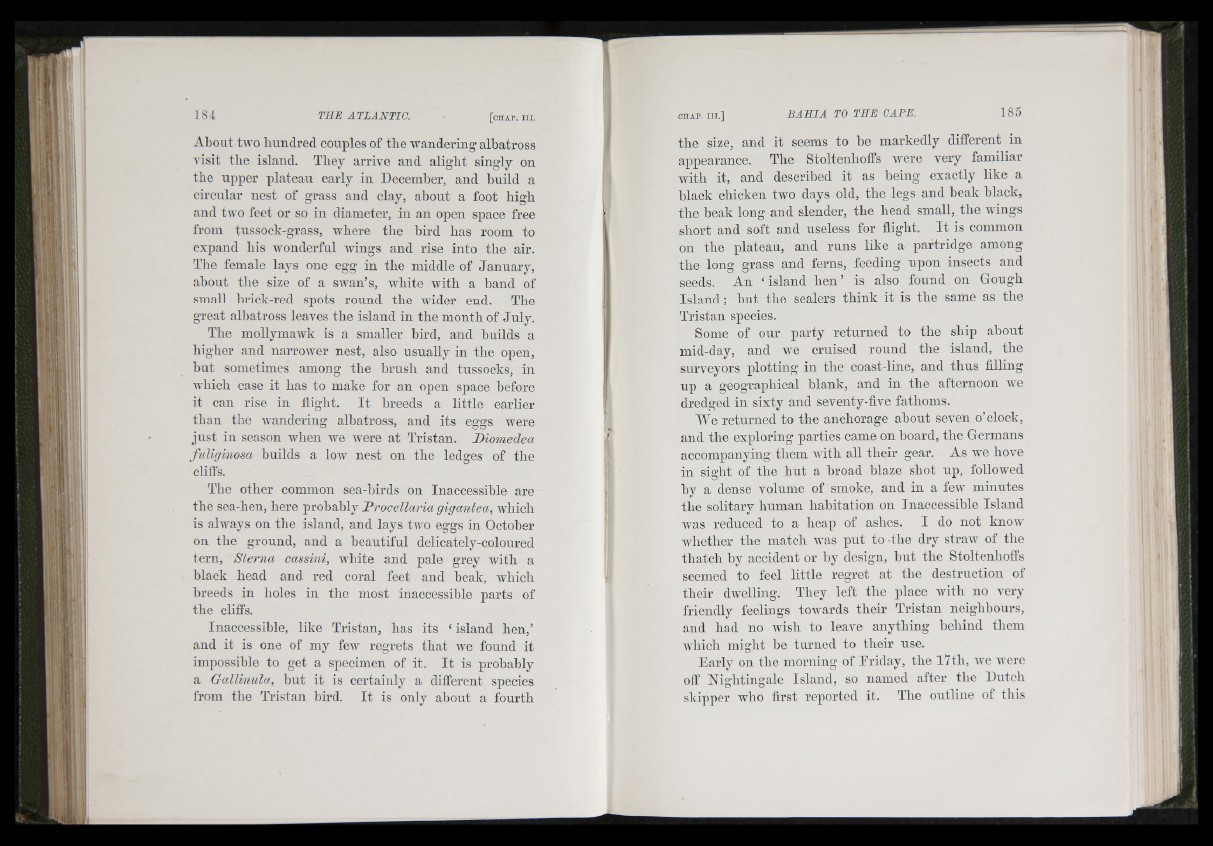
' ■Üi ní
• -1 sí
About tAA'o liundred couples of tlie wandering albatross
A’isit tlie island. Tliey arrive and alight singly on
the upper plateau early in Decemher, and build a
circular nest of grass and clay, ahout a foot high
and tivo feet or so in diameter, in an open space free
from tussock-grass, where the bird has room to
expand his wonderful wings and rise into the air.
The female lays one egg in the middle of January,
ahout the size of a swan’s, white with a hand of
small brick-red spots round the wider end. The
great albatross leaves the island in the month of July.
The mollymawk is a smaller hird, and builds a
higher and narrower nest, also usually in the open,
hut sometimes among the brush and tussocks, in
Aidiich case it has to make for an open space before
it can rise in flight. It breeds a little earlier
than the wandering albatross, and its eggs were
just in season when we were at Tristan. Diomedea
fuliginosa builds a low nest on the ledges of the
cliffs.
The other common sea-birds on Inaccessible are
the sea-hen, here probably Erocellaria gigantea, which
is always on the island, and lays two eggs in October
on the ground, and a heautiful delicately-coloured
tern, Sterna eassini, white and pale grey with a
hlack head and red coral feet and beak, which
breeds in holes in the most Inaccessible parts of
the cliffs.
Inaccessible, like Tristan, has its ‘ island hen,’
and it is one of my few regrets that we found it
impossible to get a specimen of it. It is probably
a GalUmda, but it is certainly a different species
from the Tristan bird. It is only about a fourth
the size, and it seems to be markedly different in
appearance. The Stoltenhoffs were very familiar
with it, and described it as being exactly like a
black chicken two days old, the legs and beak black,
the beak long and slender, the bead small, the wings
short and soft and useless for flight. It is common
on the plateau, and runs like a partridge among
the long grass and ferns, feeding upon insects and
seeds. An ‘ island h en ’ is also found on Gough
Island; hnt the sealers think it is the same as the
Tristan species.
Some of onr party returned to the ship ahont
mid-day, and we cruised round the island, the
surveyors plotting in the coast-line, and thus filling
up a geographical blank, and in the afternoon we
dredged in sixty and seventy-five fathoms.
We returned to the anchorage ahont seven o’clock,
and the exploring parties came on hoard, the Germans
accompanying them Avith all their gear. As Ave hove
in sight of the h n t a broad blaze shot np, followed
by a dense volume of smoke, and in a fcAv minutes
the solitary human habitation on Inaccessihle Island
Avas reduced to a heap of ashes. I do not knoAV
whether the match was put to - the dry straw of the
thatch hy accident or hy design, h\it the Stoltenhoffs
seemed to feel little regret at the destruction of
their dAvelling. They left the place with no very
friendly feelings toAvards their Tristan neighbours,
and had no wish to leave anything behind them
AAdiich might he turned to their use.
Early on the morning of Eriday, the l7 th , Ave were
off Nightingale Island, so named after the Dutch
skipper Avho first reported it. The outline of this